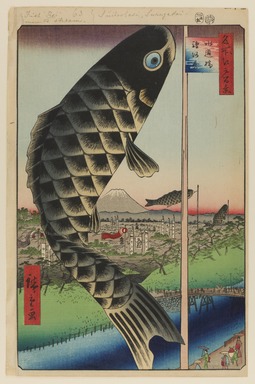
Artist:Utagawa Hiroshige
Medium: Woodblock print
Geograhical Locations:
Dates:5th month of 1857
Dimensions: Sheet: 14 1/4 x 9 1/4 in. (36.2 x 23.5 cm) Image: 13 3/8 x 8 3/4 in. (34 x 22.3 cm)
Collections:
Exhibitions:
Accession Number: 30.1478.48
Image: 30.1478.48_PS20.jpg,
Catalogue Description: This view celebrates the Boy's Festival, which takes place the 5th day of the 5th month. The scene looks across the Kanda River, over the expanse of the densest single concentration of samurai in the city, extending from Surugadai on the left through Bancho in the distance. A samurai procession passes over the Suido Bridge in the lower right. The tall banners, known as "fukinagashi" (military streamers) and the vertical "nobori" banners with portraits of Shoki, the Demon Queller of Chinese legend indicate the time is the Boys Festival, the fifth day of the fifth month. It should be noted that the designation of the month "i5"/1857 shown above, indicates that it was an extra or "intercalary" month inserted to let the calendar catch up. It was a practice for each of the samurai households to fly the banners shown here, celebrating a boy of age six or seven. The three large carps, by contrast, are marks of the "choinin" city and were used by comers for the Boys Festival imitating the military "fukinagashi," which they were prohibited from flying. According to Chinese legend, the paper and later silk carps signify a fish so strong and persistent that it could leap a waterfall. As noted in the Introduction to this series, Hiroshige himself was of samurai origin, a genuine hereditary retainer of the shogun, qualified to wear two swords and to hold formal office within a bakufu fire brigade until age thirty-six. The center shows a black free-standing fire tower. Hiroshige was undoubtedly familiar with this part of town.